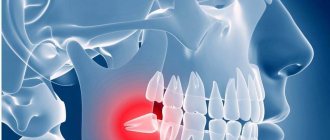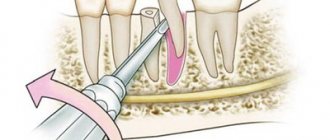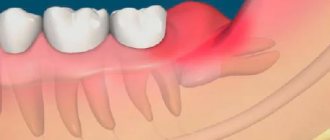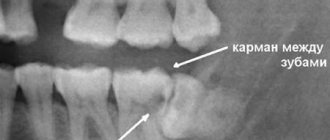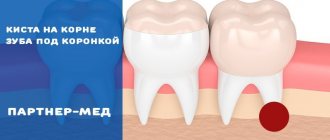If you are concerned about inflammation of the gums in the area of the mouth where the wisdom tooth is located, it is likely that you are developing pericoronitis
. The essence of this disease is that the gums that surround the tooth become inflamed. This situation usually occurs when eruption is difficult or incomplete. In practice, this disease most often occurs when the lower wisdom teeth erupt.
The pain may increase with chewing, pressing on the tooth, swallowing, or contact with hot, sour or cold foods. A feeling of discomfort may occur when opening the mouth.
Visually pericoronitis
characterized by reddened and swollen gums located near the erupting tooth, while pus may be released from the gums, and the patient’s temperature may rise to 38 degrees.
Quite often, the eruption of wisdom teeth is accompanied by complications in people, the cause of which may be insufficient space for its growth or incorrect position of the tooth in the jaw.
If a wisdom tooth does not fully erupt, a kind of hood forms over it, which is a gum that partially covers the tooth. A certain space appears between the tooth and the gum, where there are favorable conditions for the accumulation of microorganisms and food debris, which ultimately leads to the development of caries or other serious diseases.
Pericoranitis is treated surgically in a dental clinic. The gum that hangs over the wisdom tooth is incised, and the resulting wound is treated with a strong antiseptic solution. If the dentist believes that such dental treatment will not bring relief to the patient, then a decision is made to remove the wisdom tooth.
Content:
- Symptoms of the disease
- How to understand that you need to remove the figure eight hood
- Preparing for surgery
- Progress of the operation to remove the tooth hood
- Rehabilitation period
Wisdom teeth often cause problems during eruption.
As it grows, the shell of gum tissue covering it begins to rise and loses its tightness. As a result, a gap is formed between the gum and the unit. Dentists call it the “hood.” Residues of food accumulate in it. It is not possible to remove them using normal hygiene procedures. Hence - an inflammatory process that is difficult to treat, a rapid spread of painful microflora in the mouth . The gum covering the “eight” swells, increases in size, and becomes painful to the touch. This inflammation in dentistry is called pericoronitis. It requires urgent dental care as it can lead to dangerous complications. In most cases, the patient is recommended to undergo a tooth hood removal procedure.
Pericoronitis: how to treat gum inflammation at home?
Pericoronitis is accompanied by very unpleasant sensations. This disease occurs just during the eruption of a wisdom tooth, and you need to know how to relieve inflammation of the figure eight, especially in the lower jaw.
Surgical removal of the hood is only half of the treatment; the crown continues to erupt, so you need to prevent inflammation at home. It is important to give the figure eight space to erupt in a timely manner in order to eliminate infection and all its consequences. If your figure eight is erupting and this is accompanied by unpleasant symptoms, it is better not to delay and contact Leaderst dentists. At a free consultation, you will receive information that will protect you from teething problems, help you avoid tooth extraction and maintain oral health.
What to do and how to treat the gums when the figure eight erupts on the upper and lower jaws?
- Clean the oral cavity thoroughly, despite slight discomfort, since the largest number of microorganisms accumulate in the area of the erupting figure eight, which can cause pericoronitis;
- Use additional hygiene products: irrigator, rinses are very important for the prevention of gum disease not only during the teething of the figure eight, but throughout life;
- The eruption itself, even without inflammation, causes discomfort, and to relieve pain in the area of the third molar, you can take drugs such as Nimesil, Ketanov, Nise, Ibuprofen, they not only relieve pain, but also fight inflammation in the tooth area;
- Under no circumstances should you apply hot compresses to your cheek, and especially to your tooth; only cold compresses can relieve pain for a while;
- It is necessary to treat the hood not only locally, but also by following general principles, that is, eat right, avoid hypothermia, since a decrease in the protective mechanism provokes an intensification of the clinical picture, and then it will be more difficult to remove the infection and relieve pain;
- You also need to treat inflammation with folk remedies: rinse your mouth with a decoction of chamomile, sage, oak bark, and take baths.
Symptoms of the disease
The problem does not manifest itself immediately. At first, when food debris has not yet accumulated under the soft tissues, there are no inflammatory symptoms. But later the disease manifests itself with the following symptoms:
- there is an unpleasant odor from the mouth;
- pain occurs in the area of inflammation;
- gums swell and often bleed.
If the wisdom tooth hood is not removed at this stage, the inflammatory reaction will begin to occur very quickly. Then the soft tissues surrounding the “eight” will become bright red, and pus will begin to ooze from the hood. While chewing food, the patient will experience unbearable pain. Due to severe discomfort, he will be forced to limit the mobility of the diseased jaw to the maximum.
The lymph nodes may also become involved in the inflammatory reaction. An increase in body temperature and the appearance of headaches are possible.
Is there a cyst on the root of a wisdom tooth?
A cyst is a cavity filled with fluid or pus that forms primarily at the apex of the root. It can affect any tooth, including wisdom teeth. Moreover, due to its location and growth characteristics, it is more often susceptible to cystic disease than others. In approximately 40% of cases, figure eights remain completely or partially impacted and grow inside the soft tissue. This is one of the main reasons for the development of neoplasms. Experts identify a separate subtype of it, which is called “follicular wisdom tooth cyst”: it appears on the gum around an unerupted tooth and grows very quickly.
Interesting fact!
A cyst under the upper wisdom teeth will progress faster than under the lower ones. This is because the bone in the upper jaw is more porous, making it easier for infections to spread.
How to understand that you need to remove the figure eight hood
- Doctors insist on surgical treatment if:
- pus accumulates between the molar and gum;
- the pain is so severe that it is even difficult for a person to talk;
- signs of acute gingivitis appear, surrounding tissues are included in the pathological process;
- pain radiates to the temple, neck, lymph nodes;
- body temperature often rises.
All these symptoms indicate that the inflammation is very strong and measures need to be taken as soon as possible to eliminate it.
Preparing for surgery
You should not be afraid of dental hood removal surgery. It is performed under local anesthesia and does not cause serious discomfort to the patient. But for therapy to be successful, it is important to carefully prepare for it.
First, the doctor talks with the patient and listens to his complaints, finds out how long ago the inflammation occurred and how much it bothers him. Then he examines the oral cavity and palpates the inflamed area. Writes out a referral for radiography. Based on the diagnostic results, he decides whether the wisdom tooth can be saved.
A mandatory stage of preparation for surgery is taking blood tests for coagulation and some other indicators. If the inflammation is severe, the client may be prescribed antibiotics before surgery to stabilize the situation and create optimal conditions for excision of the overhanging hood.
If the doctor deems it necessary, he will first perform professional oral hygiene. During this procedure, he will remove accumulations of hard and soft dental plaque. This is necessary in order to reduce the likelihood of postoperative inflammation.
How does the healing of an extracted tooth proceed?
Knowing what your gums should look like after wisdom tooth removal will help you track negative symptoms and consult a doctor in time to eliminate them. After 15-30 minutes, a blood clot with a bright burgundy color forms in the hole. It protects internal tissues from infection and promotes successful healing.
If there is no clot, they speak of “dry socket” syndrome - an undesirable complication that leads to suppuration of the wound. In this situation, the dentist will clean the hole and fill it with anti-inflammatory gel to avoid unpleasant consequences.
On the 3-4th day, the wound begins to become covered with a white film. Over the course of 2 weeks, the hole is covered with new epithelium and is visually indistinguishable from healthy gums. Bone structures are completely restored in 4-6 months.
Progress of the operation to remove the tooth hood
When the treatment plan is drawn up, the patient has undergone the necessary preparation, and the operation is performed. It includes the following steps:
Introduction of anesthetic. The painkiller is selected on an individual basis. It is important that the patient is not allergic to it.- Excision of inflamed tissues hanging over the wisdom tooth. To do this, use a scalpel or special surgical scissors. The doctor carefully exposes the entire dental crown so that it can freely erupt to the end.
- Treatment of the resulting wound surface with an antiseptic. Removal of food debris and pus. After this, apply a turunda or compress with a wound-healing solution. It is needed to reduce the likelihood of pathogens entering the wound.
After the operation, the person can go home immediately. But on the appointed day he needs to appear for a second examination. Scheduled visits to a dental surgeon are required until the wound has completely healed.
Cyst on a wisdom tooth - what to do?
Conservative treatment of cysts has not proven its effectiveness and is practiced only in a limited number of cases. For example, when surgical intervention is temporarily contraindicated: during pregnancy and breastfeeding, after serious illnesses and operations. Physiotherapy helps to temporarily stop the spread of infection, but is not able to cope with the cyst completely and forever.
The only effective way to treat a cyst is surgery. The affected wisdom tooth cannot be saved. As a rule, this makes no sense, because “eights” do not play a key role in the chewing process. Therapy will be too complex, time-consuming and expensive, since when a tumor is removed, teeth rarely retain their integrity. Access to the last molar is difficult, and if it is dystopic or partially impacted, sooner or later it will still require extraction. The fact that patients most often discover a cyst too late, when it is no longer possible to save the tooth in any case, also plays a role.
Rehabilitation period
How long it will take for your gums to recover depends on many factors:
- volume of tissue removed;
- client age;
- individual characteristics of the patient’s body;
- correctness of the operation;
- accuracy of patient compliance with medical prescriptions.
To make rehabilitation as simple and fast as possible, you need to remember the rules:
- Do not eat for three hours after completion of surgical treatment.
- Remove the turunda (compress) only when the doctor tells you to. However, it should not be in the mouth for more than a day.
- Do not chew food on the same side of the jaw on which surgery was performed.
- Do not eat hot or very cold foods. The same goes for drinks.
- During hygiene procedures, do not touch the wound with a brush.
- Strictly take all medications prescribed by the dental surgeon.
- Do not self-medicate (it is unacceptable to try to speed up recovery using dubious folk methods).
If the patient listens to the advice of his doctor, the wound will heal quite quickly.
Extraction methods
The standard method of removal for third molars is rarely used, only on the condition that eruption has proceeded normally, and the figure eight itself is in the correct position and has a normal root structure. Dentists at the Dentospas clinic recommend performing a more gentle and safe atraumatic removal of:
- after dissection of the gums or detachment of soft tissues, the tooth is divided into segments using a special tool;
- each of the segments along with the root is removed from the hole;
- the hole is processed, if necessary, stitches are applied.
Advantages:
- atraumatic removal is gentle on bone tissue. A small part of it can be removed if the molar is dystopic or impacted. Moreover, all manipulations are controlled, the doctor precisely regulates the volume of intervention, injury is minimal;
- if there are several roots, they have a non-standard location, are directed in different directions, and interfere with neighboring teeth, the atraumatic removal technique allows you to work separately with each of them. The root is removed safely, without damaging nearby tissues, regardless of its size, direction of growth, etc.;
- recovery after atraumatic removal is faster. It takes up to several days. The risk of complications is minimal.
At the Dentospas clinic, when removing wisdom teeth, precise diagnostics are used (to assess the position, number and condition of the roots, etc.). We perform third molar extraction using several methods. After the procedure, APRF technology can be used for faster healing.
